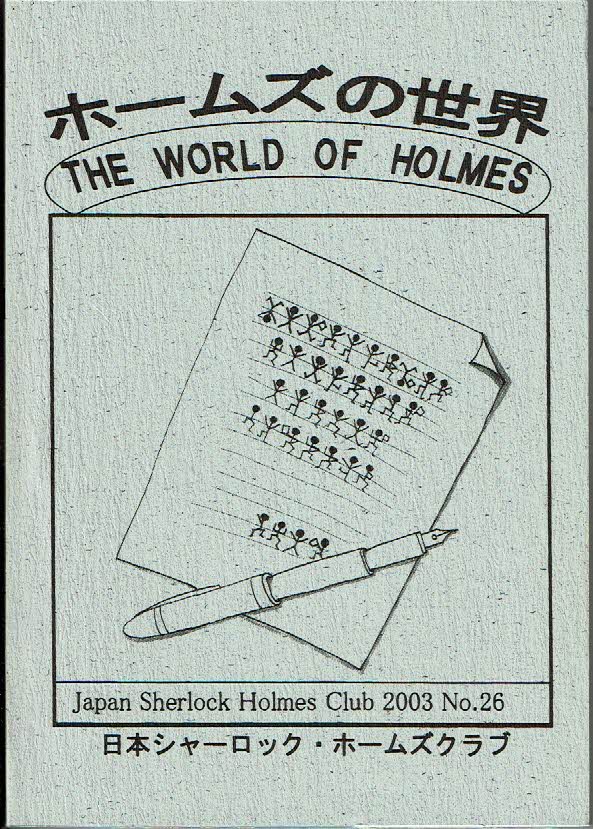The World of Holmes No.26

ホームズの世界
The World of Holmes No.26

| Watanabe, Mineki. “Sherlock Holmes and Horse Carriages” | 渡辺峯樹「ホームズと馬車」 | WH, 26(2003), 1-14. |
| A study about vehicles in the Canon, focusing on horse carriages. The author explains kinds of horse carriages and their appearances in the Canon, and estimates carriage speed based on the description in the Canon. | ||
| 正典全てに登場する乗り物、特に馬車の詳細な研究。絵や表などを豊富に用いて、馬車の種類や実際の用いられ方、物語の中の具体的な登場箇所の抽出。文中記述から、おおよその馬車の速度を推定し、当時のロンドン市街の混雑状況と辻馬車の料金までも考察。 | ||
| Transportation | ||
| Hiraga, Saburo. “Invitation to the Debate on ‘We made our way to Brussels’ |
平賀三郎「ブリュッセル論争への招待」 |
WH, 26(2003), 27-35. |
| A report on various theories about Holmes and Watson’s route from England to Brussels in LAST. | ||
| 「最後の事件」で、ホームズとワトスンの英国から大陸への行程についての研究。英国から大陸へ渡る複数のルートから、ベルギーのブリュッセルに至るルートの比較検討。当時の交通事情、時刻表、原典英語の微妙なニュアンスまで、豊富な考察。 | ||
| FINA | ||
| Date, Hisayoshi. “Three Problems in “The Red Circle”” | 伊達久義「赤い輪 三題」 | WH, 26(2003), 37-46. |
| A study about REDC on three topics: 1)The Red Circle party, 2)two ciphers, and 3)Conan Doyle syndrome. | ||
| 「赤い輪」事件についての研究。1)赤輪党について、2)文中の二つの暗号、3)コナン・ドイル症候群の三つの項目に分類。各々の項目についての詳細な研究と、他の物語との比較や、関連事項なども詳細に検討、考察する。 | ||
| REDC | ||
| Sugiyama, Shigeru. “Polite and Affectionate Expressions in the Canon” | 杉山繁「サーとプリーズとマイ・ディア・ワトスン 」 | WH, 26(2003), 48-64. |
| An analysis of polite expressions in the Canon. Counting the typical phrases, the author makes statistical analysis and how Holmes used those phrases according to the classes, occupations and genders of the people he spoke to. | ||
| 英文原作に於ける丁寧な表現、親密な呼びかけについての分析研究。一覧表やグラフを駆使して、正典中の会話についての語彙の変化や登場回数など、人物の階級や社会的立場まで、言葉遣いについての詳細で細かな考察を行っている。 | ||
| English (language) | ||
.
| Kosuge, Wataru. “Roads in Rome Lead to Sherlock Holmes” | 小菅渉「ローマの道はホームズに通ずる 」 | WH, 26(2003), 89-92. |
| A List of stories in which Rome was referred. The author describes his findings about the Roman miser and the pope. | ||
| 正典の中でのホームズとローマとの関りを研究。7つの物語の中から抽出した場面で用いられる諺や地名などのほか、ラテン語の慣用句の使用と、ローマ法王からの依頼を匂わせる言葉など。ホームズとローマ、両者の間の浅からぬ因縁について考察している。 | ||
| Europe | ||
| Kubo,Yoshihiro. “Who Was the Real Author of ‘The Hound of Baskervilles’?” | 久保恵宥「バスカヴィル家の犬 の真の作者は誰か?」 | WH, 26(2003), 93-105. |
| A study about Rodger Garrick-Steele’s claims Conan Doyle was a plagiarist and poisoner. The author describes the fuss raised by the theory, and concludes Doyle was the real author of HOUN. | ||
| かつて新聞紙上などを賑わした「バスカヴィル家の犬」盗作騒動についての研究。英国の研究家が著書で発表した、盗作・愛人を通じた友人毒殺疑惑について。様々な資料から、その推論に対して、検討と考察により否定されている。 | ||
| HOUN | ||
| Endo,Takahiko. “Sherlock Holmes Drama at the Gaiety Theater in Yokohama” | 遠藤尚彦「100年前の横浜のシャーロック・ホームズ」 | WH, 26(2003), 109-127. |
| A study about the records of the first Sherlock Holmes play in Japanese theaters. The author discovered the evidences the first Holmes drama was played on January 24, 1908 in Yokohama, which had been reported to be on July 3, 1912 by his previous presentation. | ||
| 日本に於けるホームズ劇初演記録に関する研究。今まで明治45年7月3日帝国劇場公演が最初とされていたが、著者が明治41年1月24日横浜山手ゲーテ座の公演記録を発見し、確認。更に明治36年2月27日上演の情報を得たが、確認が取れなかった顛末について。 | ||
| Japan Stages | ||
| Ichikawa, Emiko. “’The Six Napoleon’ …Why Six?” | 市川恵美子「六つのナポレオン・・・なぜ六つか?」 | WH, 26(2003), 147-154. |
| .The author thinks the ‘six’ ‘Napoleon’s plaster figure’ symbolizes certain six years in the past for Doyle and explains the reasons, comparing SIXN with BLUE. | ||
| 何故ナポレオン像の数が六つなのか?についての研究。ホームズ物語は題名に数字が入っている作品が幾つかあり、その数字の意味について考察。また「青いガーネット」との内容比較により、ドイルの作品に隠された目的についても考察。 | ||
| SIXN | ||